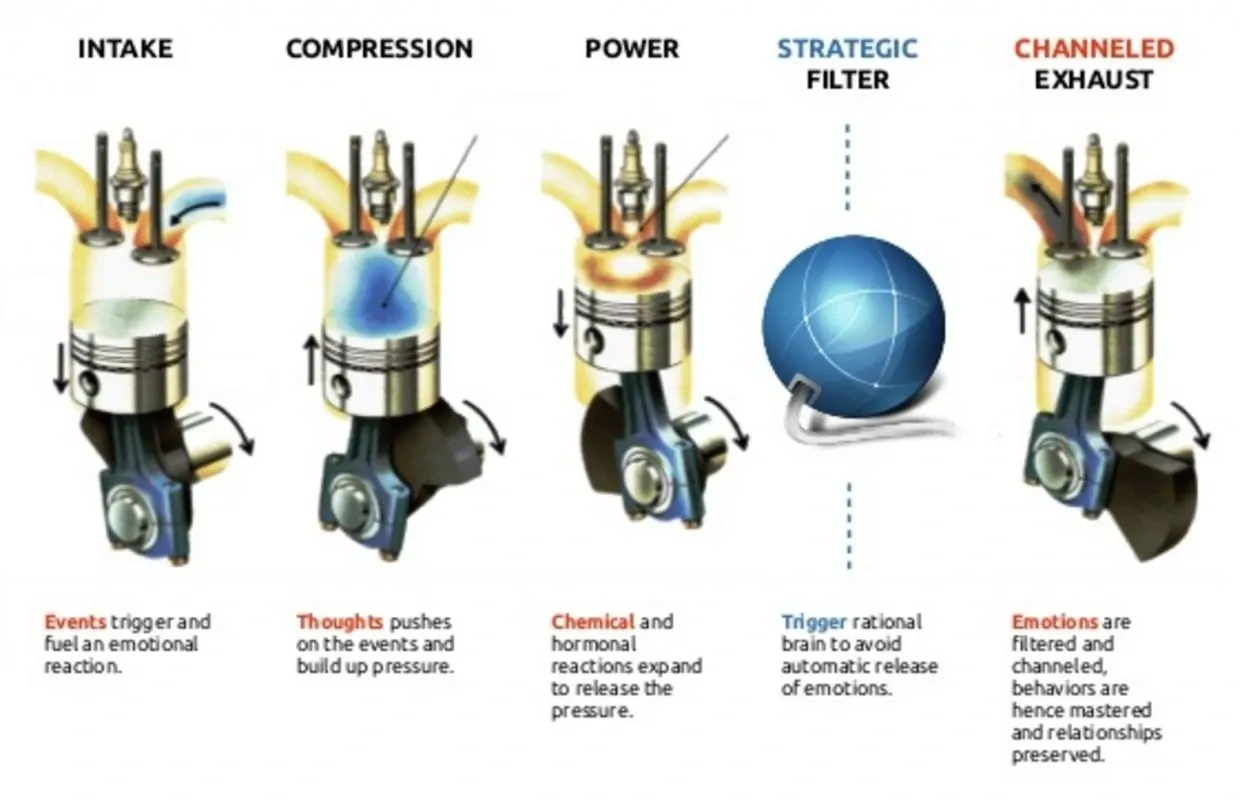Mechanics of emotions

… And why engineers can be great at dealing with emotions at work, once they get the manual.
I presented this TED-like talk for the Airbus Group Leadership University’s trainer day, held in Toulouse on 11 December 2014. In this short talk, I wanted to present to my peers a few perspectives on how to bring soft subjects like “emotions at work” to engineers, since a vast majority of Airbus managers we train come from an engineering background. The pedagogy for engineers needs to be very coherent from the title “mechanics of emotions” to the metaphors (engine), the language and the concrete cases and tools.
The following 3 perspectives are about making something that can be fuzzy, soft and intangible like emotions into clear, accessible and actionable notions and methods.
Emotions as a process
Using the metaphor of the engine can be a great way to approach the subject. There are many other images that can be used but the idea is to make the process with various steps and mechanisms appear clearly. For emotions we slow down what happens in the brain and decompose the chain of events and connections to make a simple 4-step process appear.

It is of course a simplification of what really happens but it becomes more accessible and also triggers interest so engineers are more willing to consider the subject instead of rejecting it outright. The next step once the process is presented is to ask the question “at which step do we have some leverage on the process so that what comes out (exhaust) is cleaner (less damaging for self and others)?” The exploration and questioning around the process allow for a more in-depth analysis and solution finding becomes possible: for example introducing the strategic filter (enabling a more efficient and cleaner behaviour). As in previous talks, I do not advocate the elimination of emotions but rather an acceptance and understanding of the process so it can be regulated.
Emotions as chemistry
Once the general process is understood, engineers ask themselves what is happening to my body in this process? Indeed, emotions are felt, and sometimes very strongly (depending on the intensity of emotions) in the body. We get all sorts of signals: from the temperature of our body (anger can make us feel very hot for example), the agitation in our arms and legs, to physical paralysis (stiffness in the neck or tight throat). So explaining the chemistry of emotions and its impact on the body can be very reassuring and allows people to feel “normal” – emotions are universal and very “human”. Also, knowing that for example a peak of adrenaline will only last 7 to 11 seconds gives people the opportunity to realize that “it will pass”. But understanding what happens to the body is during emotions is not enough. The next question is “why?” What is the purpose of emotions? Since it is a natural human process, why do they happen? It is not easy to understand them since they seem to create so many destructive consequences at times.
When training people about emotions management, we connect the trigger of emotions and its use to the physical consequence. Once you understand that for example anger is an emotions that gives you energy, strength and perseverance to break down obstacles and fight social injustice, it is easier to accept it and make an effort to control or focus it so that it is not destructive. Indeed, here I need to remind people that emotions and behaviours are not the same thing. It is important to distinguish the emotion (change in the internal chemistry triggered by the brain / thoughts) from the behaviour (action or reaction). Whilst the emotion can be legitimate (I am angry because I think this situation is unfair – a colleague being shouted out by my boss) my behaviour in response to the situation can be inappropriate and destructive (shouting back at my boss) or appropriate and constructive (using non violent communication to address the problem with my boss, or giving support to my colleague). Which brings us to the next perspective of using emotions as tools. If my emotion is legitimate then how do I channel it so it can serve its purpose?
Emotions as tools
It was in my TEDx Toulon speech that I introduced the notion of emotions augmented manager. Indeed, most Airbus engineers that we train have become managers, and whether it is for conflict management or driving change, they need to understand and accept emotions (for themselves and their teams) so they can use them. The two examples are typical situations for managers. In dealing with conflict, being able to express emotions (contrary to popular belief that showing emotions makes you look weak), allows people to restore a human-to-human relationship which is key if we want the conflict to be resolved in a sustainable way. Expressing emotions is at the core of non-violent communication and is how people can connect to one another because it is a universal mechanism detached from the specifics of a conflict.
In driving change in an organisation, anger for example (illustrated by the tight fist of Martin Luther King) gives people the energy and courage to speak up, the charisma to lead others and the perseverance to face the numerous obstacles and resistances. All in all it is ok to be angry, as long as this anger is channeled and directed at the problem to solve rather than the people involved in the problem. Emotions can be very powerful, and managers who can use them properly gain extra data (the signals of emotions) and extra strength. Super managers are emotions augmented managers.
So to come back to engineers, they are people like everyone else, and what makes them resistant to soft fuzzy subjects like emotions is just the way they are brought to them. Bring them the manual: the process, the chemistry and the tools and they will be great at it.





